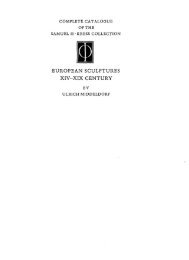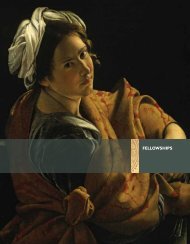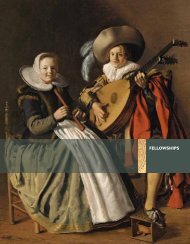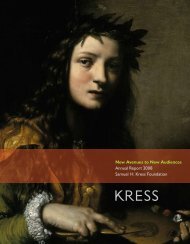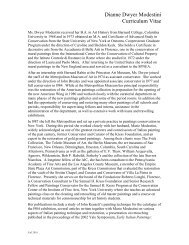The Campus Art Museum - Samuel H. Kress Foundation
The Campus Art Museum - Samuel H. Kress Foundation
The Campus Art Museum - Samuel H. Kress Foundation
You also want an ePaper? Increase the reach of your titles
YUMPU automatically turns print PDFs into web optimized ePapers that Google loves.
twelve-month position.” Most academic museums also have limited, if any, extra<br />
funds to support travel for attending conferences and other professional meetings.<br />
What counts as scholarly contributions includes debates regarding<br />
exhibitions, museum catalogues, and technological sharing of information. As<br />
noted by several curators: “Exhibitions and catalogues would not count towards<br />
tenure, even though some of those exhibitions are intellectually driven.” Along with<br />
electronic publishing, museums are active in using technology (blogs, podcasts,<br />
videos, audio tours, etc.) to communicate object-related information and knowledge.<br />
<strong>The</strong> museums with sufficient resources also digitize the objects in their collections,<br />
providing increased access for use by others. Although some of these forms of<br />
producing and sharing knowledge are clearly part of museum outreach, others<br />
could be considered forms of scholarship, though possibly not acceptable as such by<br />
tenure and promotion committees. See Appendix IV.C. for examples of educational<br />
uses of technology by museums in the study.<br />
In general, curators, educators, and other museum staff are doing remarkable<br />
work with the resources and time available. <strong>The</strong>y are knowledgeable, energetic, and<br />
enthusiastic. <strong>The</strong>y contribute to knowledge production and sharing, and are wellsituated<br />
to be key persons in facilitating a variety of educational practices.<br />
Economic Challenges<br />
Budget information was not systematically collected from museum directors.<br />
Nonetheless, it is safe to say that available funds vary widely. Each of the museums<br />
in the study has some endowments or trust funds, generally with specifications for<br />
how they can be spent (frequently for collections; sometimes for a staff position;<br />
infrequently for conservation). Each of the museums obtains some funds from<br />
museum memberships and through special events. Whether or not the museum<br />
has to rely on raising funds to help pay for day-to-day operations—for such things<br />
as environmental controls, building repairs, gallery preparation for new exhibitions,<br />
conservation of objects, publishing, photocopies, and salaries for security and<br />
professional staff—differs. In general, museum funding comes from a combination<br />
of endowments, earned income, and university or college general appropriations.<br />
Support from the parent organization tends to make up forty to sixty percent of<br />
the budget with the museum responsible for the rest. What that base amount is,<br />
however, varies, as described by directors of two different academic museums:<br />
Our budgets are quite small. Excluding salaries, we have a total operating<br />
budget of roughly $30,000 a year. Almost half that gets paid back to the<br />
university for… telephone, copiers, all that kind of stuff. So a lot of stuff is done<br />
with smoke and mirrors. We’re able to get money from donors or from small<br />
grants or other things just to supplement that on an on-going basis…. It’s a very<br />
small pot. (museum director)<br />
We are very fortunate in that [the university] provides almost all our operation<br />
budget. So I don’t need to raise money for paper for the photocopier or to buy<br />
gas for the museum van or to pay salaries, which is a real luxury. When I’m<br />
Economic Challenges<br />
20



